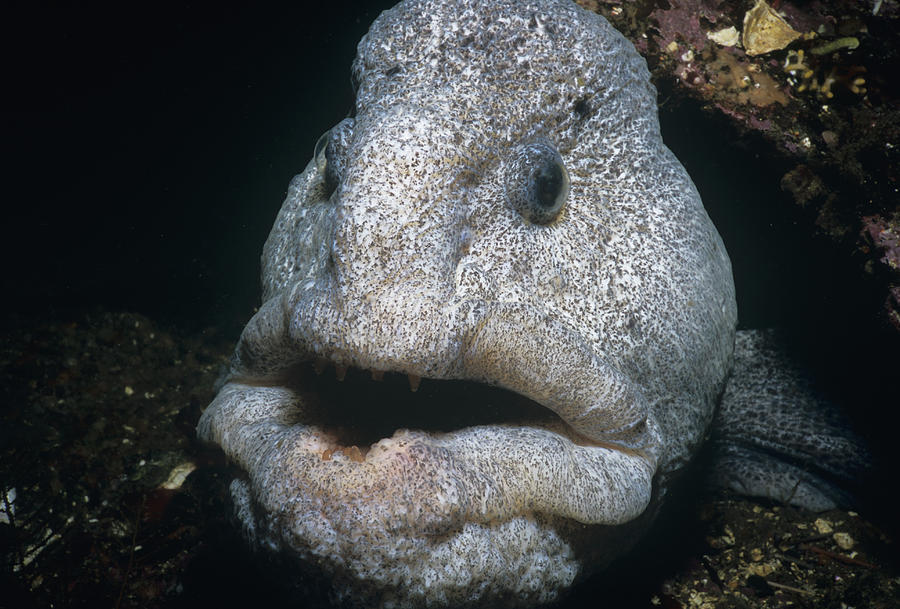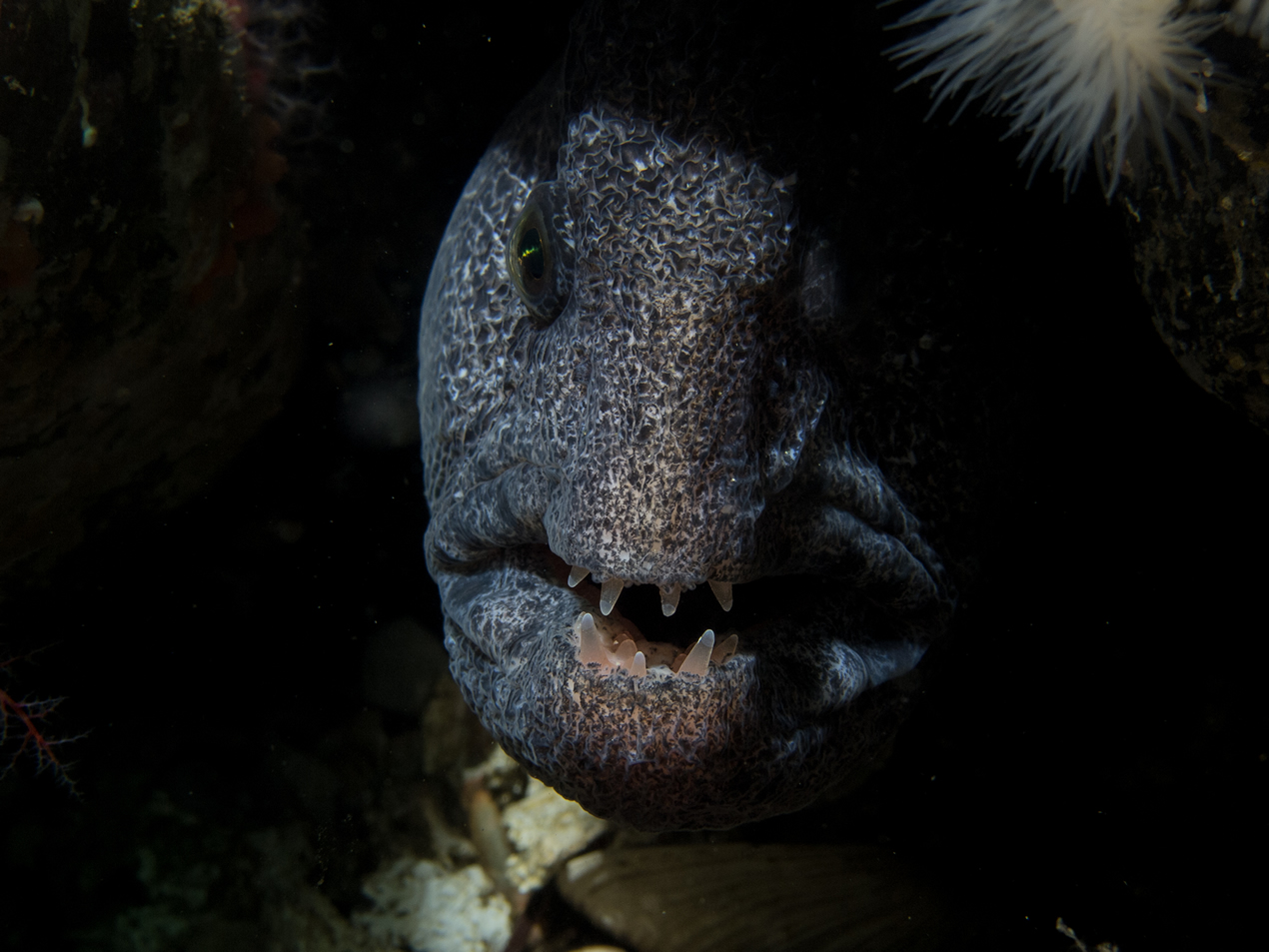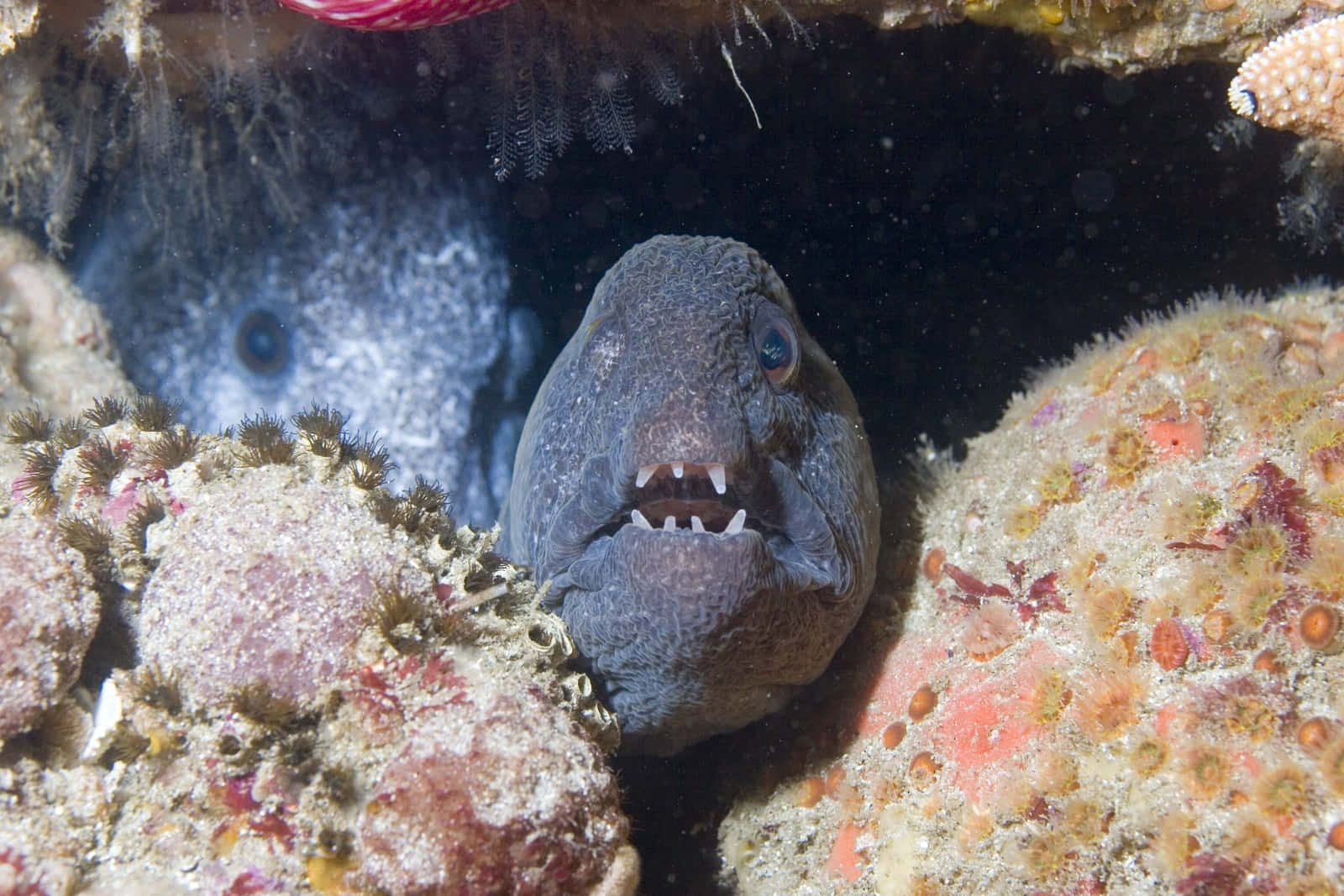Wolf Eel - Unraveling A Deep Ocean Mystery
Beneath the vast, cool surface of the Pacific Ocean, a creature with a truly distinctive look makes its home. This animal, often mistaken for something it is not, holds a special place in the underwater world. It possesses a unique appearance, a rather long body, and a set of strong mouth parts that might, you know, seem a bit intimidating at first glance. Yet, despite its somewhat stern expression, this ocean dweller is, in fact, quite fascinating and, arguably, not what many people imagine when they first hear its name.
This particular fish, which, as a matter of fact, is not a true eel, typically lives in the colder parts of the northern Pacific. It prefers the quiet, stony areas of the ocean floor, where it can find shelter among the rocks and tall underwater plants. For a creature that can grow to be quite substantial in size, it tends to be rather good at moving through its environment, almost seeming to glide through the water with surprising ease. We are, you see, talking about a fish that has, in some respects, been given a reputation that doesn't quite match its true nature.
Recently, this creature even became a topic of wide discussion after a short video, showing it in an unusual circumstance, gained a lot of attention. That, you know, made many wonder about its capabilities and whether its powerful bite could be truly harmful. So, if you've ever found yourself curious about this long, somewhat mysterious fish of the deep, then you're in the right spot to learn more about its life, its habits, and what makes it such a special part of the ocean's living tapestry.
Table of Contents
- What is a Wolf Eel, Really?
- Where do Wolf Eels Live?
- Are Wolf Eels Dangerous?
- What do Wolf Eels Eat?
- How Long do Wolf Eels Live?
- Wolf Eel Size and Weight
- Wolf Eel Behavior and Habits
- The Misunderstood Wolf Eel
What is a Wolf Eel, Really?
When you hear the name "wolf eel," it's pretty natural to picture a creature that's part wolf, part slithery eel. But, actually, that image is, you know, a bit off the mark. The wolf eel, despite its common name and its long, winding body shape, is not, in fact, a true eel at all. It's simply a type of fish, a very long and rather slender one, that belongs to a different family entirely. Its body can be as gray as a cloudy sky, and it has a rather distinctive facial feature, a sort of unique nose shape, that sets it apart from many other fish you might encounter in the ocean.
People sometimes describe this fish as having a rather serious, almost grumpy look on its face, which, in a way, just adds to its overall charm and mystery. It possesses a set of very large mouth parts and teeth that are quite pointed, designed for a specific purpose in its ocean home. As these fish grow older, their initial brighter shades tend to become duller, settling into more muted tones of gray and brown. So, while it might not be what you expect from its name, the wolf eel is, you know, truly a one-of-a-kind fish with a memorable appearance that certainly stands out in the deep blue.
Where do Wolf Eels Live?
The wolf eel makes its home in the cool waters of the North Pacific Ocean, particularly along the Pacific coast of North America. You'll typically find them preferring to stay close to the ocean floor, especially in places where there are plenty of rocks and crevices to hide in. They really enjoy the stony areas on the bottom of the sea, the underwater rock formations, and those tall, swaying underwater plant groves, often called kelp forests. These specific spots provide them with shelter and, of course, plenty of opportunities to find their next meal, which is, you know, quite important for any creature.
They are, in fact, creatures of the deep, preferring depths that most of us would find quite astonishing. Their living space typically spans from about 316 meters down to 416 meters below the surface. To put that into perspective, that's roughly from 1,036 feet to 1,365 feet beneath the waves. So, basically, these fish are accustomed to a rather dark and pressure-filled environment, a place where the sun's rays barely, if ever, reach. It's a rather quiet and secluded existence for the wolf eel, living in these deep, hidden parts of the ocean.
Are Wolf Eels Dangerous?
The question of whether a wolf eel's bite is truly harmful is one that often comes up, especially after a certain video made the rounds on the internet. In that video, a wolf eel, even after a severe injury, was seen still capable of biting a soda can, which, you know, certainly showed off its jaw strength. It's true that wolf eels possess very strong mouth parts and teeth that are quite sharp. These features are, in fact, built for crushing and breaking apart the tough outer coverings of their prey, not really for attacking larger animals or humans. So, in a way, their appearance and capabilities can seem a bit intimidating.
However, wolf eels are generally not aggressive creatures towards people. They tend to be quite shy and prefer to keep to themselves, staying hidden in their rocky homes. Any reports of bites on humans are extremely rare and usually happen when a wolf eel feels threatened or is provoked, perhaps if someone tries to handle it. So, while their bite could certainly cause a serious injury due to their powerful jaws, it's not typically life-threatening, and they are not known for actively seeking out trouble. They are, in fact, often described as being rather gentle, despite their somewhat stern appearance and the strength of their bite.
What do Wolf Eels Eat?
The wolf eel's diet is, you know, quite specific, and it perfectly matches their powerful mouth parts and pointed teeth. These creatures are, in essence, built to break apart and pulverize the tough outer coverings of their food. Their main meals consist of animals that have hard, protective casings, like crabs, sea urchins, clams, and various snails. They use their impressive jaw structure to smash and chew through these strong defenses, getting to the softer parts inside. So, basically, they are like the ocean's natural shell-crackers.
Despite their size, these fish are also surprisingly quick and nimble when it comes to finding and catching their food. Their body structure is, in fact, built in a particular way that allows them to move quietly through the underwater rock formations and plant groves, making them effective hunters. They are, you see, quite skilled at sneaking up on their unsuspecting prey. It's a testament to how specialized they are for their particular way of life in the deep, rocky parts of the ocean. Their diet, in short, is a key part of what makes them such unique residents of the Pacific.
How Long do Wolf Eels Live?
It might surprise you to learn that wolf eels can live for a good long time in their ocean homes. These fascinating fish have, in fact, been known to reach an age of at least 28 years. That's quite a significant lifespan for a fish, especially when you consider all the challenges of living in the deep ocean. Their ability to live for so many years speaks to their resilience and how well-suited they are to their particular environment. It suggests that they have, you know, developed effective ways to survive and thrive over extended periods.
This longevity is, arguably, a result of several factors, including their preferred deep, sheltered habitats, which may offer some protection from predators and disturbances. Also, their specialized diet and hunting methods mean they are very efficient at getting the nutrition they need. So, basically, a wolf eel can be a long-term resident of its chosen rocky crevice, potentially spending decades in the same general area of the ocean floor. It's a rather impressive feat for a fish that often gets a reputation for being, well, a bit intimidating.
Wolf Eel Size and Weight
When we talk about the wolf eel, we're discussing a fish that can grow to be quite substantial in size. They are, in fact, known for their impressive length, capable of reaching up to eight feet long. To give you a picture, that's roughly the height of a small room or a very tall person stretched out. Their long, winding shape contributes to this considerable length, making them truly stand out among other fish in their habitat. So, you know, when you imagine one, think long and lean, but with a surprising amount of bulk.
In terms of how much they weigh, a fully grown wolf eel can tip the scales at up to 40.5 pounds. This weight, combined with their length, makes them a rather solid and powerful creature of the deep. It's interesting to note that while they are quite large, their body structure is, in fact, designed for moving with ease through their complex environments, like coral-like structures made of stone. So, basically, they are big, but they are also quite nimble, which helps them navigate their rocky homes and hunt for their meals effectively.
Wolf Eel Behavior and Habits
Wolf eels spend most of their time tucked away in the stony areas of the ocean bottom, or in the crevices of rocky reefs and the dense parts of kelp forests. They are, in fact, rather solitary creatures, preferring to have their own space. Their long, thin bodies are perfectly suited for moving quietly through these complex underwater landscapes. They are, you know, quite skilled at using their body shape to their advantage, allowing them to glide through narrow openings and around obstacles with ease. This ability to move with ease is, arguably, a key part of their survival strategy.
Despite their somewhat serious facial expressions, wolf eels are not typically known for being aggressive. They tend to be quite calm and, you know, prefer to avoid confrontations. When they do move, it's often with a deliberate, almost graceful motion, as they search for food or find a new hiding spot. Their bones are built in a particular way that helps them with this movement, allowing them to be both large and quick when they need to be. So, basically, they are masters of their environment, moving with a quiet confidence that reflects their long years of living in the deep.
The Misunderstood Wolf Eel
For a creature that can appear rather intimidating with its powerful mouth parts and long, winding body, the wolf eel is, in some respects, one of the most often not seen for what it truly is beneath the waves. People sometimes get them wrong, seeing them as fearsome predators, when in reality, they are quite shy and, arguably, rather gentle. Their somewhat stern facial features might give them a grumpy look, but this is simply how they are built, not a sign of their disposition. So, you know, appearances can certainly be deceiving when it comes to these fish.
The stories and viral videos that highlight their strength can, in a way, add to this misunderstanding. While it's true they have strong jaws, this is for eating hard-shelled prey, not for being a threat to humans. They are, in fact, an important part of their ocean ecosystem, playing a role in controlling populations of sea urchins and other bottom-dwelling creatures. So, basically, the wolf eel is a fascinating example of how a creature's true nature can be quite different from its initial impression, reminding us to look closer at the wonders of the deep.
This article has explored the wolf eel, a unique fish found in the North Pacific Ocean, often mistaken for a true eel due to its long, slender body. We've looked at its distinctive appearance, including its powerful jaws and sharp teeth, and learned that despite a viral video showcasing its bite strength, it is generally not a threat to humans unless provoked. The wolf eel's preferred habitats, such as stony bottoms and kelp forests, and its diet of hard-shelled prey were discussed. We also covered its impressive lifespan, reaching at least 28 years, and its substantial size, growing up to eight feet long and weighing over 40 pounds. Finally, we touched upon its shy, solitary behavior, highlighting how this creature is often misunderstood, despite its rather serious expression.

Wolf-eel Photograph by Jeff Rotman - Fine Art America

Images of a wolf eel - hooliluxe

Download Wolf Eel Peeking From Rocky Crevice Wallpaper | Wallpapers.com